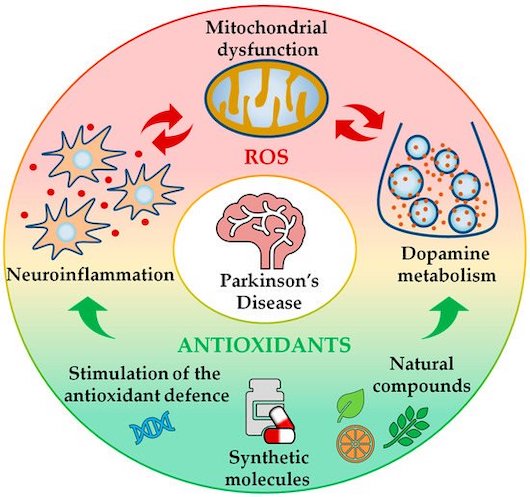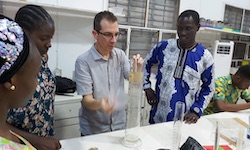REDOX BIOLOGY IN NEURODEGENERATION
Reactive oxygen species (ROS) play an important role as endogenous mediators in several cellular signalling pathways, but are kept in check by a host of antioxidant mechanisms[1]. When ROS production overwhelms the antioxidant defence mechanisms they can cause widespread oxidative damage by reacting with many macromolecules including DNA, proteins and lipids[2]. The precise balance between ROS production and their removal via numerous enzymatic and nonenzymatic molecules is of fundamental importance for cell survival. Accordingly, many neurodegenerative disorders, including Parkinson’s disease (PD), are associated with excessive levels of ROS and oxidative damage[3]. Oxidative injury has been identified as one of the principal factors involved in the progression of PD and several indications are now reported in the literature highlighting the prominent role of the superoxide radical in inducing neuronal toxicity.
The conservation of most of the PD-related genes between humans and D. melanogaster, along with the animal’s rapid life cycle and the versatility of genetic tools, makes fruit flies an ideal experimental system for rapid screening of antioxidant-based treatments. We have assessed, by genetic and pharmacological manipulations, the therapeutic potential of antioxidant strategies[4], in particular, the use of SOD-mimetic molecules, which can selectively remove superoxide radicals[5]. Thus, superoxide anions represent potential cellular targets for new drugs offering a novel therapeutic approach to cope with the progression of PD[6]. We are also exploring the role of oxidative stress on other neurodegenerative diseases include Amyotrophic lateral sclerosis/frontotemporal dementia (ALS/FTD).
REFERENCES
- Sies H & Jones DP (2020)
Reactive oxygen species (ROS) as pleiotropic physiological signalling agents.
Nat Rev Mol Cell Biol 21, 363-383 - Murphy MP & Hartley RC (2018)
Mitochondria as a therapeutic target for common pathologies.
Nat Rev Drug Discov 17, 865-886 - De Lazzari F, Bubacco L, Whitworth AJ & Bisaglia M (2018)
Superoxide radical dismutation as new therapeutic strategy in Parkinson's disease.
Aging Dis 9, 716-728 - Filograna R, Godena VK, Sanchez-Martinez A, Ferrari E, Casella L, Beltramini M, Bubacco L, Whitworth AJ & Bisaglia M (2016)
SOD-mimetic M40403 is protective in cell and fly models of paraquat toxicity: Implications for Parkinson disease.
J Biol Chem 291, 9257-9267 - Biosa A, Sanchez-Martinez A, Filograna R, Terriente-Felix A, Alam SM, Beltramini M, Bubacco L, Bisaglia M & Whitworth AJ (2018)
Superoxide dismutating molecules rescue the toxic effects of PINK1 and parkin loss.
Hum Mol Genet 27, 1618-1629 - De Lazzari F, Sandrelli F, Whitworth AJ & Bisaglia M (2020)
Antioxidant Therapy in Parkinson’s Disease: Insights from Drosophila melanogaster.
Antioxidants 9, 52



